Ode to Hummingbird by Pablo Neruda
The hummingbird in flight is a water-spark...
There is something very special about the hummingbird. These small, flying jewels are unlike any other birds. Like dancing light, they are delightful to watch yet maddeningly difficult to photograph! Pablo Neruda, the 1971 Nobel Prize winner for Literature, beautifully captures these tiny birds in his poem, Ode to Hummingbird.
Ode to Hummingbird by Pablo Neruda
The hummingbird
in flight
is a water-spark,
an incandescent drip
of American
fire,
the jungle's
flaming resume,
a heavenly,
precise
rainbow:
the hummingbird is
an arc,
a golden
thread,
a green
bonfire!
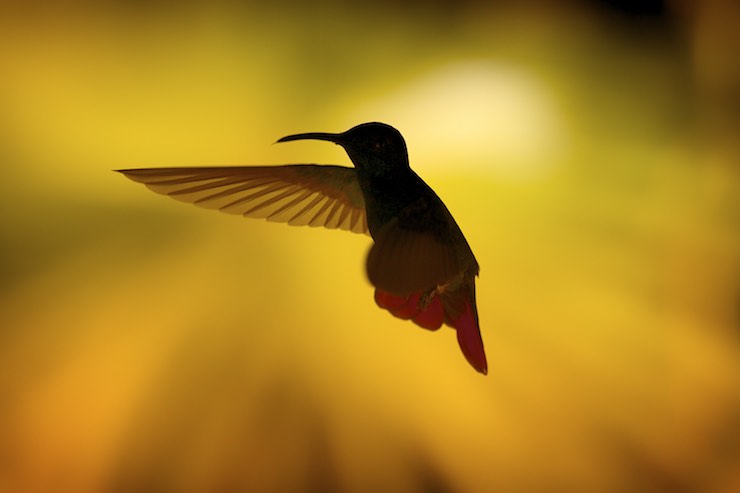
Oh
tiny
living
lightning,
when
you hover
in the air,
you are
a body of pollen,
a feather
or hot coal,
I ask you:
What is your substance?
Perhaps during the blind age
of the Deluge,
within fertility's
mud,
when the rose
crystallized
in an anthracite fist,
and metals matriculated
each one in
a secret gallery
perhaps then
from a wounded reptile
some fragment rolled,
a golden atom,
the last cosmic scale,
a drop of terrestrial fire
took flight,
suspending your splendor,
your iridescent,
swift sapphire.
You doze
on a nut,
fit into a diminutive blossom;
you are an arrow,
a pattern,
a coat-of-arms,
honey's vibrato, pollen's ray;
you are so stouthearted--
the falcon
with his black plumage
does not daunt you:
you pirouette,
a light within the light,
air within the air.
Wrapped in your wings,
you penetrate the sheath
of a quivering flower,
not fearing
that her nuptial honey
may take off your head!
From scarlet to dusty gold,
to yellow flames,
to the rare
ashen emerald,
to the orange and black velvet
of our girdle gilded by sunflowers,
to the sketch
like
amber thorns,
your Epiphany,
little supreme being,
you are a miracle,
shimmering
from torrid California
to Patagonia's whistling,
bitter wind.
You are a sun-seed,
plumed
fire,
a miniature
flag
in flight,
a petal of silenced nations,
a syllable
of buried blood,
a feather
of an ancient heart,
submerged
The Chimpanzees of Fauna: Seeing Past the Bars
This post has been updated since it previously appeared in 2014.
For the past four and a half years I have been fortunate to volunteer my time photographing the remarkable chimpazees at the Fauna Sanctuary outside Montreal. This extraordinary place is home to 14 chimpanzees, 3 monkeys and a menagerie of rescued farm animals. The chimps and monkeys have, for the most part, arrived here from research labs, zoos or the entertainment industry. Because of humans, they no longer live a free and natural life in the wilderness and are reliant on caregivers in sanctuary to tend to their needs.
Chimpanzees are large, wild animals with tremendous strength and intelligence. After spending more than 20 years alone in a small lab cage, enduring endless medical procedures, no individual could emerge without physical and psychological scars. So it is for these chimpanzees. They live with their pain, with their memories; saddled with demons and struggling with illness. They are courageous souls who have had to develop new life skills, adapt to unnatural environments and learn to trust, or at the very least, rely on humans–the fellow primates responsible for their lives in captivity.
I am honoured that most days they allow me to photograph them. Believe me when I tell you if they do not want their picture taken, it does not get taken. They walk away, turn their heads, hide, or use more emphatical means to discourage my attention. They communicate very clearly to me–this is their choice.
As a photographer and story-teller, it is my responsibility to portray them with the dignity they deserve and I seek to reveal their remarkable personalities, their complex relationships and deep emotions. My objective is always to tell their story in a truthful and respectful manner.
Frankly, I am awed in their presence. They can just as easily disrupt as inspire my creative process! I am humbled when I am with them. I learn so much from the compassionate caregivers who try to make their lives easier and more enjoyable, allowing them to make decisions–choosing where they wander, who they spend time with, what they eat...always trying to provide them with choices.
On Chimpanzees and Cages...
 Let's be perfectly clear; these chimpanzees did not choose to live this way. This is our doing. Our choice. When I have an image posted of one of these sentient beings living at Fauna and I read comments that some people dislikes or would prefer not to see the "cages" or the "bars," it bothers me for several reasons.
Let's be perfectly clear; these chimpanzees did not choose to live this way. This is our doing. Our choice. When I have an image posted of one of these sentient beings living at Fauna and I read comments that some people dislikes or would prefer not to see the "cages" or the "bars," it bothers me for several reasons.
To begin with, the chimpanzees at Fauna do not live in "cages."
These are the cages many of them once lived in. This is an actual cell from LEMSIP that now sits in the woods on the Fauna property, out of sight of the chimpanzees, but very much present to anyone working or visiting the property. These were the bars they once lived behind...
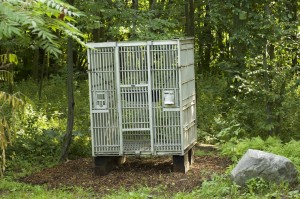
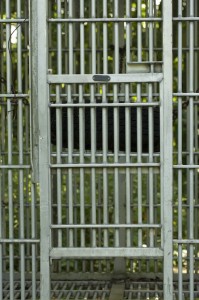
...these are the cages, that thankfully for these fourteen chimps, have been left behind.

Their living space at Fauna is enclosed, absolutely, with electric wire, metal bars, locked doors, concrete walls, and even a moat. But they have acres of land, both inside their Chimphouse with its enormous ceilings and bright, unbarred windows, as well as on the acres of islands dotted with treehouses, hammocks and climbing structures. Elevated above the islands and leading away from the house are iron skywalks with canvas covers and see-through windshields in inclimate weather. The chimps can walk around outside, find quiet places to nap or be with friends while still enjoying some protection from rain and wind.
However, they need to stay safe. Their caregivers need to stay safe. So, they need to be enclosed.
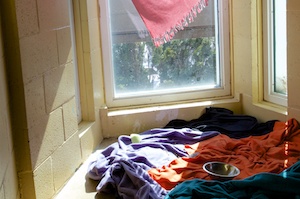
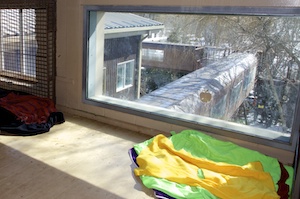
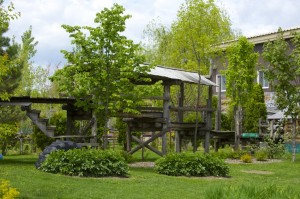
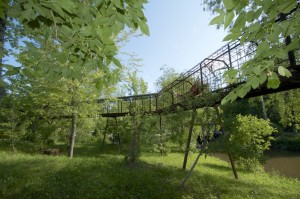
Above: There is always available bedding to build night nests in the windows of the Chimphoue. Below: Island structures and outside skywalks.
So, why is it that we do not want to see the metal? Do we feel less guilty seeing them without the bars? We are so privileged to give witness to their lives–an opportunity that should never have been afforded us–should we not accept the terms that we created for them as they live this life they did not choose? To me, with or without the bars, they are the same remarkable, powerful, thoughtful and emotional chimpanzees. This is who I see. This is who I photograph.


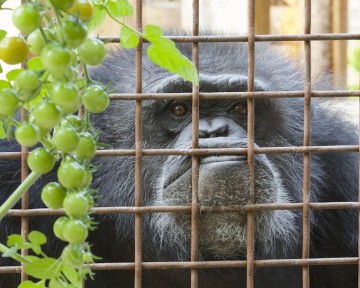
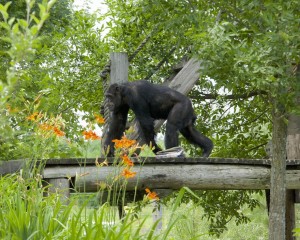
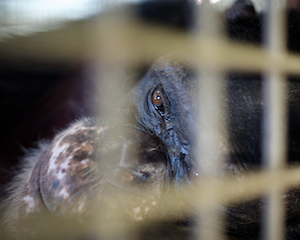
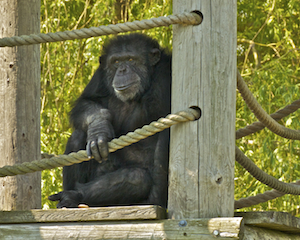
When you are looking at one my photos of the Fauna chimps, you are seeing what I choose to show you. I make an emotional and creative decision. Of course I like to see the chimpanzees without obstacles in front of their beautiful faces. I push my skills to discover better techniques for creating images that will make the bars "disappear." The work is very difficult and long with far more failure than success. But when they choose to co-operate, I feel they have offered me a great gift and that I must not let them down.
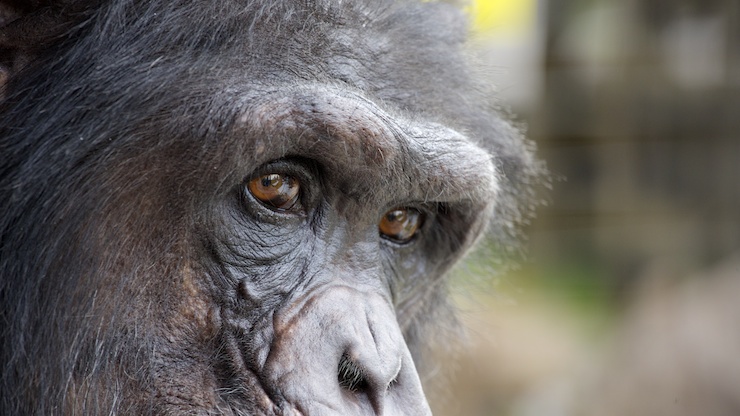
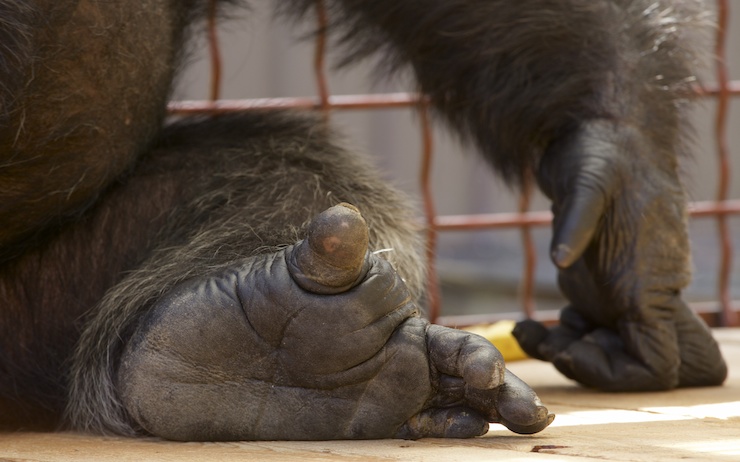
I do this work because I want to represent them and to help tell their stories. For these chimpanzees, their lives, their stories — past and present — take place behind bars. That will not change. Be mindful that as a photographer I am creating an image–making a moment. Regardless of what I choose to show you in my photos, make no mistake; the enclosures — the bars — they are always present...but lets all remember why they are there.




For these fourteen chimpanzees, thankfully, their home is no longer a cage. But there will always be locks, electrical wire and bars. Perhaps we can all look a little harder to see past them.
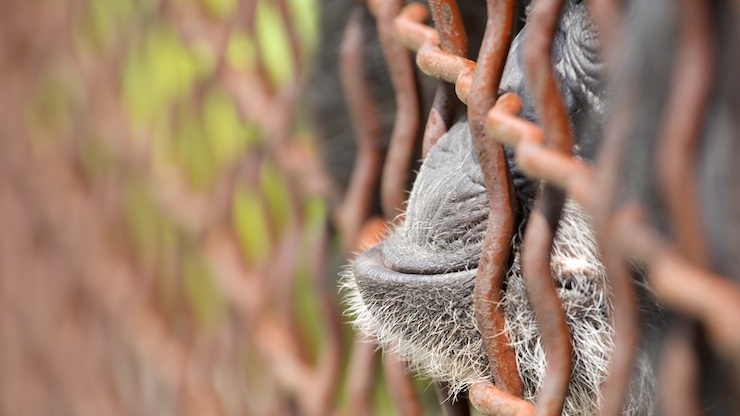

All photos © NJ Wight
Thank you Gloria Grow for all that you do and for inviting me into this world. I am forever grateful.
You can support the Fauna chimps by visiting www.faunafoundation.org.
95% Chimp
Binky and the Mirror: Reflections on a Courageous Chimpanzee
If Binky had been born in the wild he would have stayed with his Mother, nursing, for up to five years. Then he would have hung around a few more years learning how to care for his younger siblings in the troop. But Binky did not grow up in the wild. In 1989, Binky was born at LEMSIP (The Laboratory for Experimental Medicine and Surgery in Primates) and was allowed to stay with his Mother, in a small cage, for only three months.
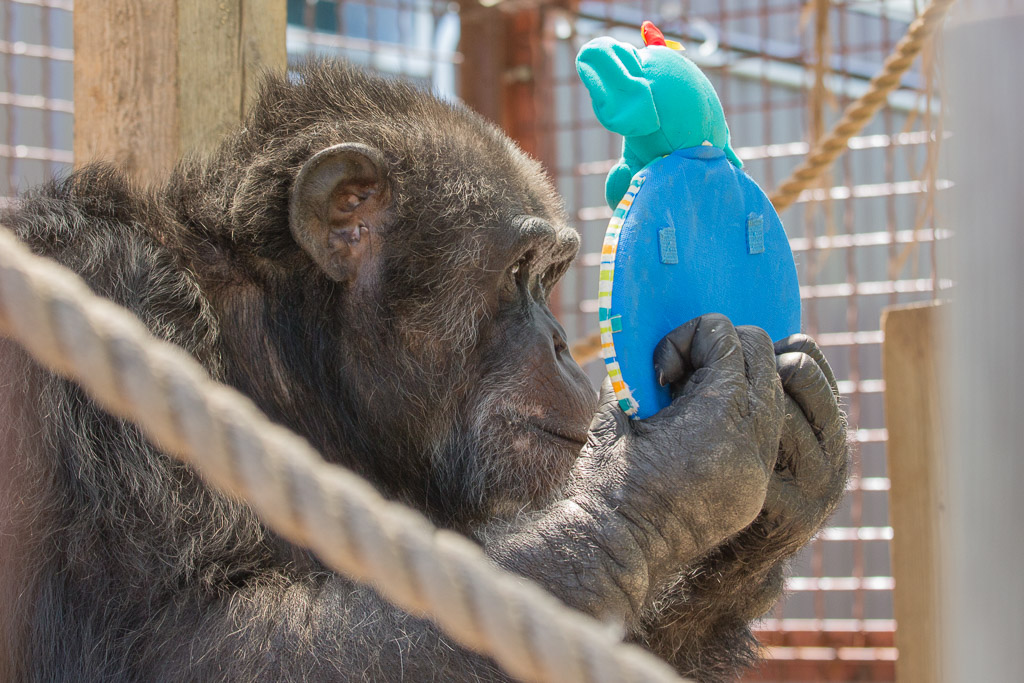
During his eight years in the lab, Ch-665 as he was called, was knocked down by dart some 136 times, mostly for cage changes and teeth cleanings. He was used in four studies in seven years and was generally considered to be a ‘well-adjusted individual’ – even though by the time he was three years old he was being treated for self-inflicted wounds.
Binky was one of the "lucky" ones. He was released into sanctuary at Fauna Foundation on September 12, 1997 when he was just eight years old. Binky has been able to live these past 20 years in a safe environment with other chimpanzees, where he is loved, respected, and given the freedom to make choices for himself. He has a better life now, but make no mistake, it is not a life of his choosing.
Mirror, Mirror...
One day while I was taking photographs at Fauna, I saw Binky walk along the skywalk above me heading towards the back islands with something blue in his hand. I was curious to see what he was up to and so, after waiting a minute or two, I quietly walked to the back enclosure to see if he was visible to photograph. When I found him he was sitting all by himself up on a platform and looking into a small plastic mirror attached to a plush elephant. I didn’t want to startle him so I started humming quietly while I slowly moved towards the opposite side of the enclosure. He looked up and saw me and watched me for a few seconds and then returned to his mirror.
I have seen the chimpanzees grooming themselves, and each other, many times, but this was a first for me. Binky was holding the mirror in one hand while he groomed his feet, carefully licking between his toes. When he was finished, he moved on to his face and then his teeth. He did not take his eye off his reflection and his expression was very thoughtful and focused.
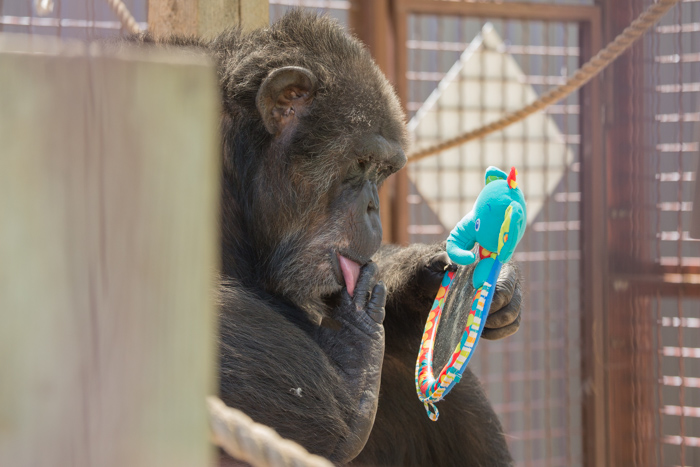
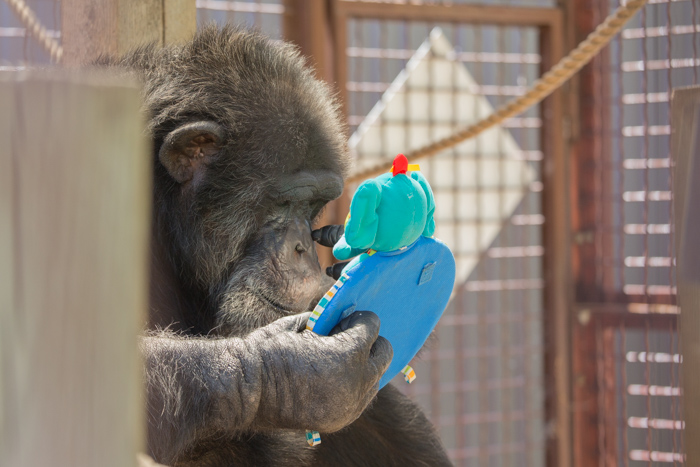
I started to click away as he continued to groom, moving slowly, trying to find small openings between the caging and surrounding gardens. I wanted to position myself in such a way that I might get lucky and capture his face in the mirror or the beautiful sunlight reflecting back.
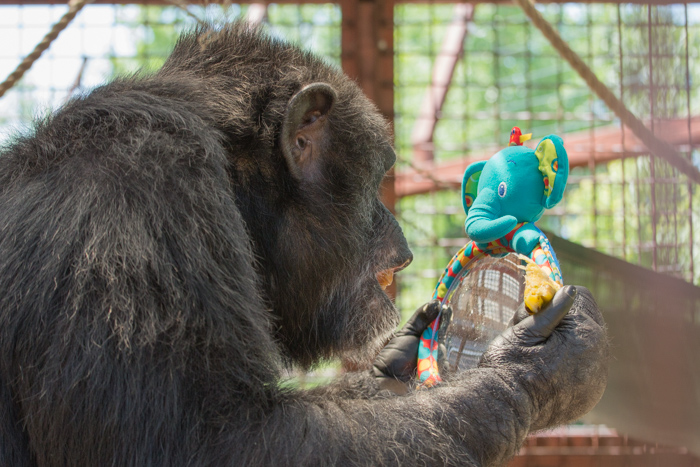
Understandably, the chimps rarely follow my art direction so I rely mostly on stamina and luck! After several minutes with my arms extended and my shoulders starting to ache a little, Binky moved the mirror to just the right spot and a bounce of sunlight lit up his very handsome face. After five years as the paparazza to the primates this photograph is certainly one of my very favourites and I was happy it was choosen for the front cover of the 2015 Fauna Annual Report.

Enrichment for Chimpanzees
Enrichment, which includes activities that promote physical activity and mental stimulation, is essential for the well-being of not just the chimpanzees living at Fauna, but for all captive chimps. In the wild there are ongoing challenges to engage their intellect and in sanctuary, the Fauna caregivers work very hard to provide enrichment in various forms. (See Enrichment with Mary Lee and Tatu for more.) Plastic mirrors are a favourite for some of the chimpanzees but they enjoy lots of differnt kinds of toys. If you would like to donate enrichment items, you can consult these Everyday Items on the Fauna website.
Binky, I am blessed to know you. You are courageous, loving, kind and good. To look into your eyes is a gift to my soul.
Thank you.
This is post was originally published on www.faunafoundation.org.
Masai Mara Musings
“If I have ever seen magic, it has been in Africa.” –John Hemingway
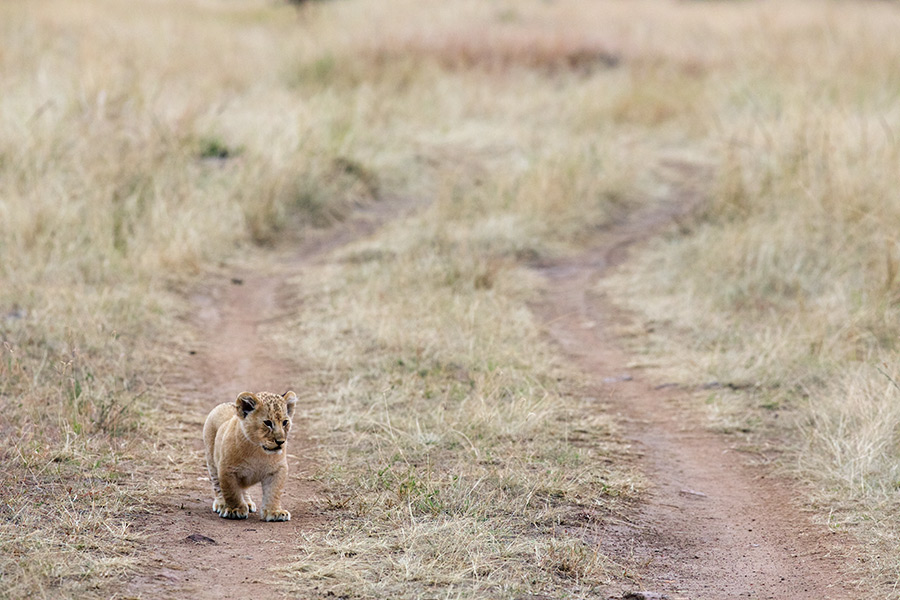
Lion Prides
During my time in the Olare and Mara North conservancies, I was fortunate to spend time with the Enkoyanai and the Iseketa-Monika prides and also visited some old feline friends from the Cheli & Peacock pride. It has always been fascinating for me to return to the same conservancies over the past three years and follow the lives of some of the resident prides. It is certainly tough going for lions these days as their numbers continue to fall with a population now estimated at around 20,000 across Africa. It is a complex challenge and lions are losing the battle to loss of habitat, conflict with humans, pesticides and big game hunting (The Economics of Hunting Lions). I am ever-thankful for my incredible Masaai guides Mika and Patrick of Kicheche Camps for their deep knowledge of the lion families and their willingness to share. They are on the front lines witnessing the stress on the balance of nature and are exceptional in their leadership and stewardship of these important lands.

Highlights of my recent lion sightings included watching a couple of youngsters from the Enkoyanai pride in Olare Orak exploring their territory and having a tumble with each other. Another exciting lion encounter was following two big boys, Lolpapit and Barnoti, the dominant coalition in charge of the Iseketa-Monika pride in the Olare conservancy. Sure they could use a little hair product, but their strength is formidable and on this morning they were approaching the Enkoyanai pride with a mission to intimidate. (Ok, maybe not so intimidating when they took time out to wrestle with each other.)

Elephant Greetings
Another very special moment in Olare was watching two herds of elephants greet each other as daylight faded away. There was a great deal of trunk caressing and playful greetings between the adolescents and the little ones insisted on joining in where they could. The sky was overcast and there was a strange pinky-blue hue to the last light, which is so magical in the Masai Mara, making it extremely difficult to capture these living landscapes. I worked at it until the bitter end, shooting with a 300 at f2.8 and pushing ISO's as high as 10,000. While the images are technically flawed , they will serve me well as reminders of one of the most spectacular elephant sightings of my many trips.

The Masai Mara on my Mind
When I get home from my adventures, I spend long days editing photos and reliving my memories. Even years later, when I look at the images, vivid memories return. It gets under your skin. The longing to return soon follows.







